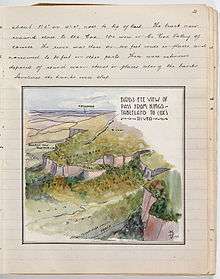Myles and Milo Dunphy
| Myles Dunphy OBE | |
|---|---|
| Born |
Myles Joseph Dunphy 1891 South Melbourne, Victoria, Australia |
| Died |
1985 Peakhurst, New South Wales, Australia |
| Nationality | Australian |
| Occupation | Conservationist |
| Known for | Protection of Blue Mountains National Park |

Myles Dunphy and Milo Dunphy were Australian conservationists who played an important role in creating the Australian wilderness movement.
Myles Dunphy
Myles Joseph Dunphy OBE (1891-1985) was an Australian conservationist best known for the protection of parts of the Blue Mountains National Park.
Biography
Myles Dunphy lived in Oatley, a southern suburb of Sydney, and started his wilderness publicity work in 1910. He compiled detailed maps of a number of areas of conservation interest in New South Wales. His original maps of the Blue Mountains, in particular the Coxs River and Kowmung River catchments, featured imaginative and original naming systems. Throughout his life he campaigned for wilderness areas throughout New South Wales.
His interest in bushwalking led to the foundation of the Mountain Trails Club of New South Wales, and was influential in the formation of the Sydney Bushwalkers and the Confederation of Bushwalking Clubs in 1932. He also formed the National Parks and Primitive Areas Council, and took steps to establish a professional parks service.
He was appointed an Officer of the Order of the British Empire in 1976 in recognition of service to conservation,[1] and was awarded an IUCN Packer Award for Long Merit in National Parks.
Milo Dunphy
| Milo Dunphy AM | |
|---|---|
| Born |
Milo Kanangra Dunphy 1928 |
| Died | 1996 |
| Nationality | Australian |
| Occupation | Conservationist |
| Known for | Formation of the Australian Conservation Foundation |
Milo Kanangra Dunphy AM (1928-1996), the son of Myles Dunphy, was an Australian conservationist best known for the reinvigoration of the Australian Conservation Foundation and his political activism to preserve wilderness areas in New South Wales.
Biography
Milo Dunphy was an activist who campaigned on several fronts. He was known for his work in the preservation of the Colong Caves, which were being targeted for limestone mining, and also for his contribution to the preservation of the Boyd Plateau, which was to be planted with lime trees. He helped to double the area of national park space in New South Wales from 2 to 4.5 percent.
He accompanied his parents, Myles and Margaret, as an infant in 1930-31 on bushwalks in the Blue Mountains. A special perambulator with an iron frame, a wicket basket with hood and rubber-tyred wheels, nicknamed 'the Kanangra Express', was used to wheel him through rough terrain.[2]
Milo Dunphy stood as a candidate in the 1974 federal election, as a candidate for the Australia Party for the Division of Cook; and in the 1983 federal election, as an independent candidate for the Division of Bennelong against John Howard, at that time Treasurer (and later Prime Minister).[3] Dunphy Jnr. was active through Australian conservation organisations including the Australian Conservation Foundation,[4] the Colong Foundation for Wilderness, the Nature Conservation Council, and the Total Environment Centre, of which he was the founding Director.[5] He was appointed a Member of the Order of Australia in 1986 for services to conservation,[6] received the Sydney Luker Award from the Australian Institute of Planning, and an honorary degree from the University of New South Wales.
Shared legacy
The work of the Dunphy family continues through the Dunphy Wilderness Fund, which purchases leasehold and privately held areas of natural significance, spending A$1 million per annum (since September 1996).[7]
The Colong Foundation, the successor to Myles Dunphy's National Parks and Primitive Areas Council, is Australia's longest-serving community advocate for wilderness.
References
- ↑ "Myles Dunphy, OBE". It's an Honour. Commonwealth of Australia. 31 December 1976. Retrieved 2 April 2013.
- ↑ "Pram known as the 'Kanangra Express'". National Museum of Australia.
- ↑ Jones, Hon. Richard (24 April 1996). Adjournment speech (Speech). Hansard. Legislative Council of New South Wales.
- ↑ Sinclair, John (1999). "Eulogy to Milo Dunphy". National Parks Journal. 43 (4).
- ↑ Faulkner, John (8 May 1989). "Maiden speech". Hansard. Parliament of Australia. Retrieved 2 April 2013.
- ↑ "Milo Dunphy, AM". It's an Honour. Commonwealth of Australia. 9 June 1986. Retrieved 2 April 2013.
- ↑ The Dunphy Wilderness Fund, retrieved 6 April 2015
Further Reading
- Meredith, Peter, Myles and Milo, St Leonards: Allen & Unwin, 1999
- Richard Gowers (2007), "Dunphy, Myles Joseph (1891–1985)", Australian Dictionary of Biography, National Centre of Biography, Australian National University, retrieved 6 April 2015